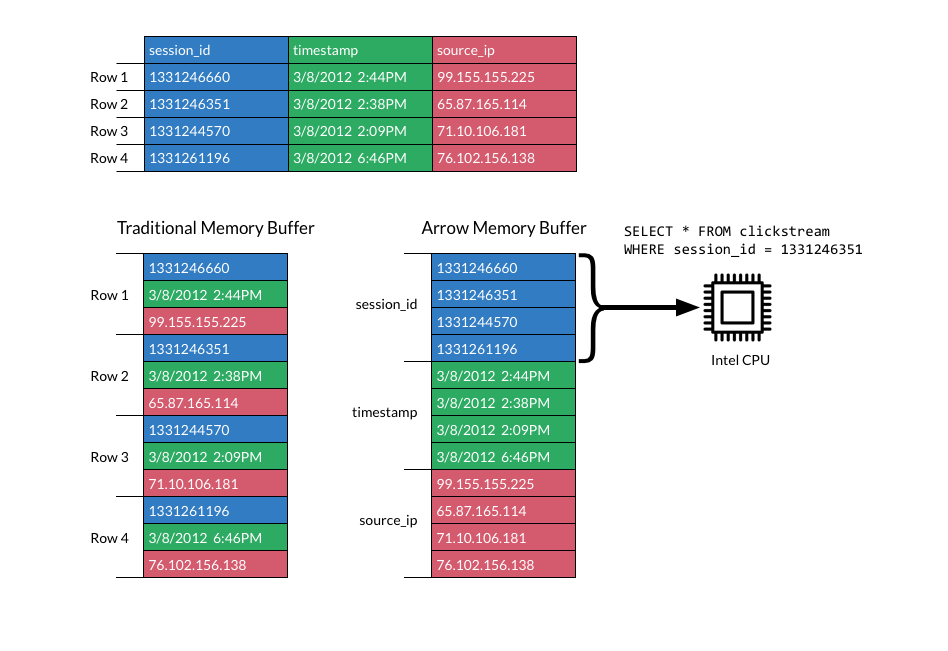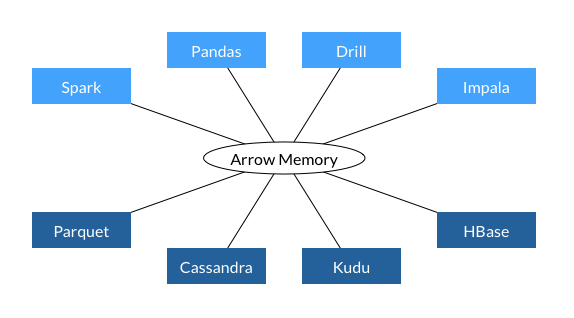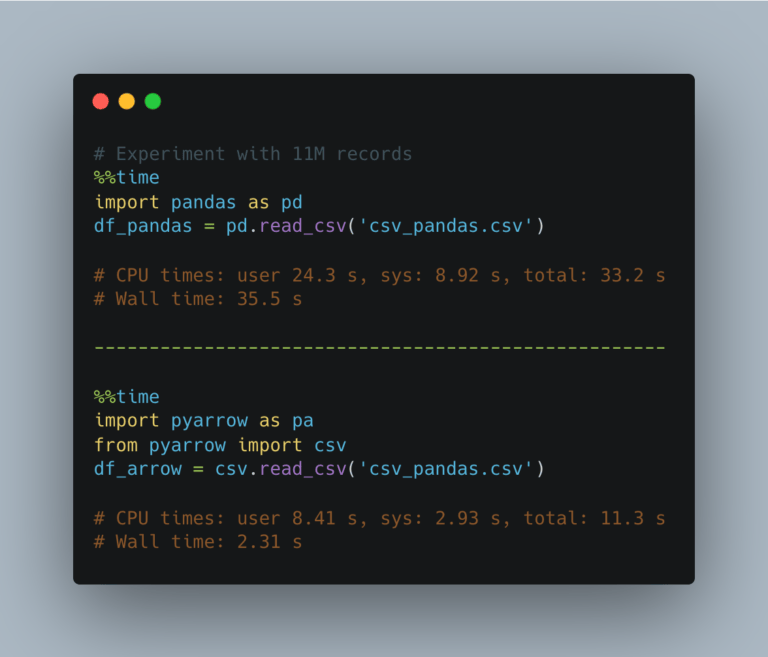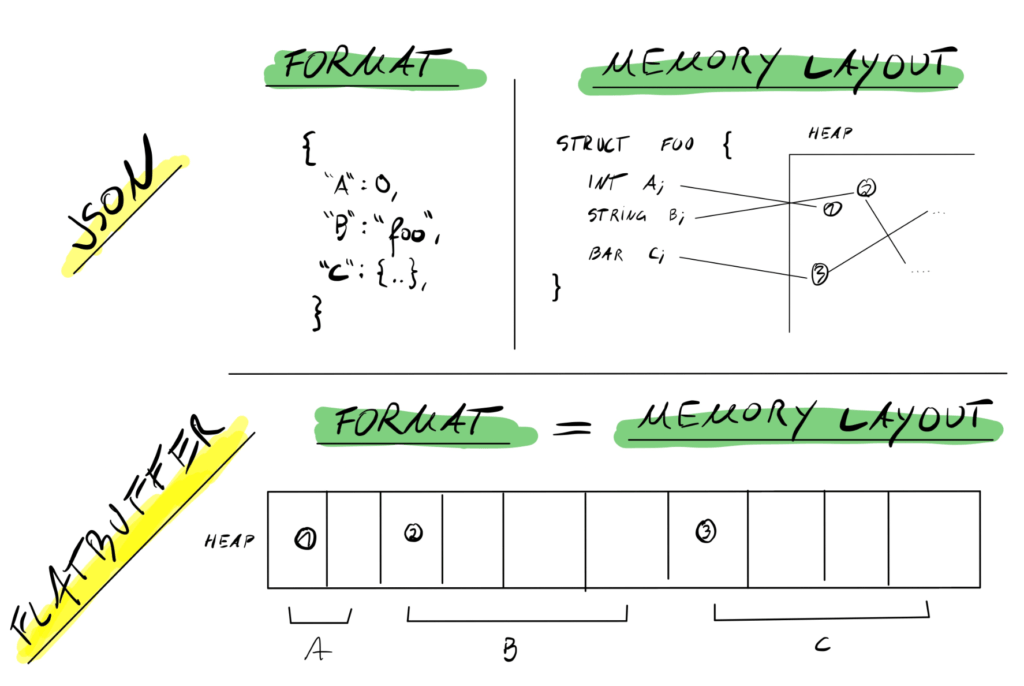什么是Arrow
Apache Arrow是一个开源的跨平台数据层开发框架,主要提供高效的、硬件加速的内存中数据计算能力。Apache Arrow的设计初衷是作为“新一代大数据系统的共享基础”,可以作为不同系统之间进行高效数据交换的媒介,同时提供快速、低延迟的数据访问接口。
Apache Arrow的主要目标是通过提供一个开放的标准,解决大数据领域常见的问题:大量的数据复制和序列化/反序列化操作所带来的性能问题,以及跨平台和跨语言环境下的数据兼容性问题。具体的,Apache Arrow的优势有以下几个方面:
- Apache Arrow的列式内存格式设计优化了数据的随机访问,让每次数据访问的复杂度达到了O(1),即无论数据的规模大小,数据的访问时间都保持常数。这种设计能够更好地利用现代硬件的特性,如CPU的缓存局部性、流水线和SIMD指令集,从而进一步提升数据处理的效率。同时列式存储可以高效地执行数据密集型的计算操作,如过滤、排序和聚合等。

- Apache Arrow实现了一套标准的、跨语言的数据交换协议,采用了零拷贝(Zero-Copy)的设计理念,能够在不同语言、不同数据处理框架之间共享数据,而无需进行数据的转换和复制操作。

下图是Arrow和Pandas在读取csv数据时的性能对比。

总体来说,Apache Arrow正在重新定义我们如何在大规模数据环境下进行高效、灵活的数据处理和计算。下面将深入探讨Apache Arrow的各个方面,以便更好地理解其工作原理和实际应用。
数据模型和内存模型
Apache Arrow的数据模型设计主要基于列式存储,这种设计方式允许数据被组织和存储为一系列的列,而不是传统的行。在这种模型下,每一列的数据都存储在一起,而不是与其他列的数据混杂在一起。这种模型对于数据分析非常有效,因为数据分析通常是基于列的(比如计算一个字段的平均值或者统计某个字段的唯一值的个数)。
Apache Arrow的内存模型采用了类似“平面格式(FlatBuffer)”的设计,数据被组织为一系列连续的内存块,每个块独立地表示一个字段的所有值。这使得数据可以在内存中直接处理,避免了序列化或反序列化操作。同时,其设计了“零拷贝”机制,使得不同的数据处理框架能在无需复制数据的情况下共享数据,降低了数据传输和转换的开销。

在Java SDK中,Arrow的ValueVector均为off-heap的,也就是说我们需要手动去管理对象的生命周期,避免内存泄漏的问题。
Apache Arrow 关键抽象
在Apache Arrow中,有一些关键的抽象概念,它们形成了Apache Arrow数据处理框架的基础。本文将之分为数据相关和内存相关。
数据相关
其中数据相关概念包括ValueVector、Field、Schema、VectorSchemaRoot以及Table,下面将对它们进行详细的解释。
ValueVector
ValueVector代表一列相同类型的值,每个ValueVector实例代表一个字段,其中包含了该字段的所有值。Apache Arrow提供了各种各样的ValueVector的子类,用来表示各种类型的数据,比如IntVector用于表示整数,VarCharVector用于表示字符串等。类似的,还有BigIntVector、Float4Vector、Float8Vector、DateDayVector、ListVector、MapVector、StructVector等等
IntVector ageVector = new IntVector("age", allocator);
VarCharVector nameVector = new VarCharVector("name", allocator);Field
Field表示某一列的元数据,包括列名、列类型、是否允许为null,以及一个元数据映射。每个Field对象都与一个ValueVector对象对应,Field对象描述了ValueVector的元数据信息。
Field age = new Field("age",
FieldType.nullable(new ArrowType.Int(32, true)),
/*children*/null
);
Field name = new Field("name",
FieldType.nullable(new ArrowType.Utf8()),
/*children*/null
);Schema
Schema是一系列Field的组合,它描述了表格的结构,也可以包含一个元数据映射。
Schema schema = new Schema(asList(age, name), /*metadata*/ null);VectorSchemaRoot
VectorSchemaRoot是由ValueVectors和Schema组合的关键抽象,它可以表示完整的表格数据。你可以理解为行存储中的List<Record>。
下面是一个创建VectorSchemaRoot的例子:
try(
BufferAllocator allocator = new RootAllocator();
VectorSchemaRoot root = VectorSchemaRoot.create(schema, allocator);
IntVector ageVector = (IntVector) root.getVector("age");
VarCharVector nameVector = (VarCharVector) root.getVector("name");
){
root.setRowCount(3);
ageVector.allocateNew(3);
ageVector.set(0, 10);
ageVector.set(1, 20);
ageVector.set(2, 30);
nameVector.allocateNew(3);
nameVector.set(0, "Dave".getBytes(StandardCharsets.UTF_8));
nameVector.set(1, "Peter".getBytes(StandardCharsets.UTF_8));
nameVector.set(2, "Mary".getBytes(StandardCharsets.UTF_8));
System.out.println("VectorSchemaRoot created: \n" + root.contentToTSVString());
}输出:
VectorSchemaRoot created:
age name
10 Dave
20 Peter
30 Mary在这个例子中,我们创建了一个包含两列的表格,分别是”age”和”name”。然后我们在这个表格中添加了3行数据。这个例子展示了如何使用Apache Arrow的Java SDK来创建和操作表格数据。
在实际应用中存在几个问题:
1.如果设计这样一个函数VectorSchemaRoot getVectorSchemaRoot(),在函数中就不能close任何资源,但是在函数外只能close VectorSchemaRoot本身。
因此一个合理的实践可能是函数传入allocator,如VectorSchemaRoot getVectorSchemaRoot(BufferAllocator allocator),然后再函数外显式关闭VectorSchemaRoot和BufferAllocator。
这里做了个实验,即如果只关闭VectorSchemaRoot,不关闭BufferAllocator也是不会发生内存泄漏的,但是,这需要你非常小心地管理你的资源。
public void memoryLeakTest() {
RootAllocator rootAllocator = new RootAllocator(Long.MAX_VALUE);
try (VectorSchemaRoot root = TestUtils.getTestVectorSchemaRoot(rootAllocator)) {
System.out.println(rootAllocator.getAllocatedMemory()); // 32823
// root.close()
}
Assert.assertEquals(0L, rootAllocator.getAllocatedMemory()); // 0
System.out.println("No memory leak detected.");
}2.VectorSchemaRoot不可能将一个大表中所有数据都读进内存,当表特别大时,其只相当于一个batch的数据。因此流式处理数据,或包装成一个ArrowReader来返回可能是一个不错的选择。以下是一个流式处理的例子:
public static void dealWithArrowStream(byte[] arrowStream) {
List<VectorSchemaRoot> roots = new ArrayList<>();
try (ArrowFileReader reader = new ArrowFileReader(new SeekableReadChannel(new ByteArrayReadableSeekableByteChannel(arrowStream)), null)) {
List<ArrowBlock> recordBatches = reader.getRecordBlocks();
for (ArrowBlock recordBatch : recordBatches) {
reader.loadRecordBatch(recordBatch);
VectorSchemaRoot root = reader.getVectorSchemaRoot();
// do something
}
} catch (IOException e) {
e.printStackTrace();
}
}Table (experimental)
就像Immutable且不支持批处理的VectorSchemaRoot,可以通过API将VectorSchemaRoot的数据转移到一个Table中(注意是转移而非复制)
Table t = new Table(someVectorSchemaRoot);Table API 提供了一种以行为中心,基于列的方式处理内存中的大规模数据的高效方式。当你需要在 JVM 环境中处理大规模数据,并且希望能够高效地利用现代硬件的能力时,Table API 是一个非常好的选择。
内存相关
ArrowBuf
Arrow内存分配最底层的单位,包含内存的地址和偏移量,类似于ByteBuffer。其属于Direct Memory而非分配在heap上,以支持zero-copy的设计理念。
BufferAllocator
RootAllocator本身并不直接占有内存。RootAllocator的主要作用是跟踪和限制通过它分配的内存。在Apache Arrow中,内存分配是通过树形的分配器结构进行的,RootAllocator是这个结构的根。
try(BufferAllocator bufferAllocator = new RootAllocator(8 * 1024)){
ArrowBuf arrowBuf = bufferAllocator.buffer(4 * 1024);
System.out.println(arrowBuf);
arrowBuf.close();
}Reference counting
由于Arrow主要使用non-heap memory,无法被JVM自行垃圾回收,因此其自行实现了垃圾回收机制。
Apache Arrow 中的内存管理模型使用了引用计数(reference counting)来跟踪和管理内存。当一个内存块被分配或者共享时,参考计数会增加,当内存不再被使用时,参考计数会减少。当参考计数减至零时,那么这块内存会被释放。
每个通过 Apache Arrow 分配器(Allocator)创建的数据结构都包含一个参考计数。例如,当你创建一个 Arrow Vector 时,它的参考计数被设置为 1。如果你克隆这个 Vector,那么原始 Vector 和克隆的 Vector 都会指向同一块内存,而且这块内存的参考计数会增加到 2。当任何一个 Vector 不再被使用并调用 close() 方法时,它会减少内存的参考计数。当所有的 Vector 都不再被使用时,参考计数会变为零,然后内存会被释放。
Apache Arrow 数据流
Apache Arrow 提供了一种 IPC (进程间通信) 机制,使得在不同的进程,甚至不同的机器之间,可以无缝地共享和传输数据。Arrow IPC 机制能够在不进行数据复制的情况下,高效地传输大规模数据。
将 Arrow 序列化和反序列化在生产中十分常见,以下是一个简单的例子,针对小批量数据进行处理。
import org.apache.arrow.vector.*;
import org.apache.arrow.vector.ipc.*;
public class ArrowIPCExample {
public byte[] serializeBatch(VectorSchemaRoot root) throws IOException {
ByteArrayOutputStream out = new ByteArrayOutputStream();
try (ArrowStreamWriter writer = new ArrowStreamWriter(root, null, out)) {
writer.start();
writer.writeBatch();
writer.end();
}
return out.toByteArray();
}
public VectorSchemaRoot deserializeBatch(byte[] data, BufferAllocator allocator) throws IOException {
ByteArrayInputStream in = new ByteArrayInputStream(data);
try (ArrowStreamReader reader = new ArrowStreamReader(in, allocator)) {
if (!reader.loadNextBatch()) {
throw new IOException("Expected one batch in Arrow stream");
}
return reader.getVectorSchemaRoot();
}
}
}大规模数据通常需要分batch流式处理,上面介绍VectorSchemaRoot时候给出了流式读取ArrowStream处理的例子,另一种可行的方式返回一个ArrowReader,返回给函数调用者自行处理。
ArrowReader reader = new ArrowStreamReader(getInputStream(), allocator, compressionFactory);
while (arrowReader.loadNextBatch()) {
VectorSchemaRoot vectorSchemaRoot = arrowReader.getVectorSchemaRoot();
// do something
}
总结
本文学习并总结了Arrow最基础的知识,并通过Java语言给出了一些实践。实际上,Arrow还有很多强大的进阶特性,如Compression、Arrow Flight,Dataset、Data manipulation、Avro、Arrow JDBC Adapter等。